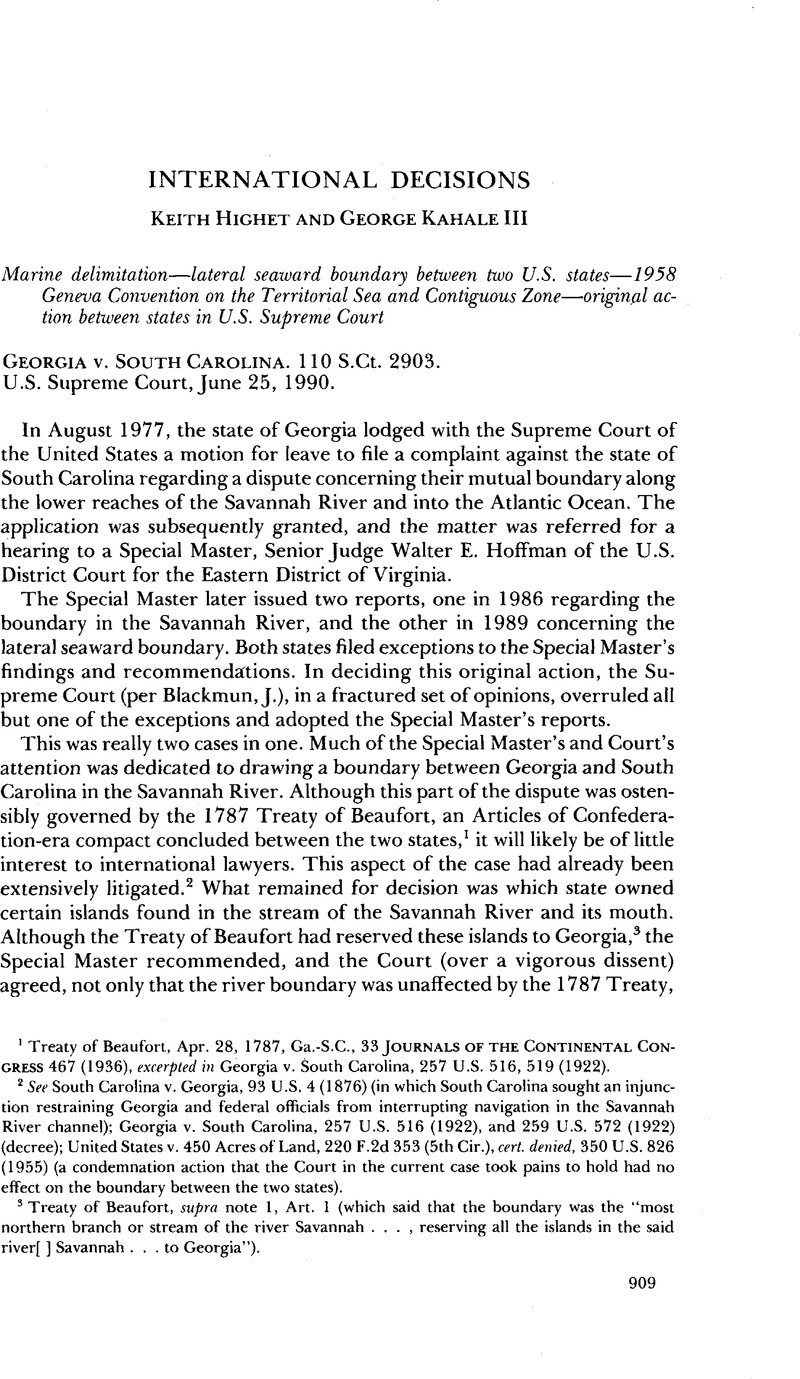Article contents
Georgia v. South Carolina
Published online by Cambridge University Press: 27 February 2017
Abstract

- Type
- International Decisions
- Information
- Copyright
- Copyright © American Society of International Law 1990
References
1 Treaty of Beaufort, Apr. 28, 1787, Ga.-S.C, 33 Journals of the Continental Congress 467 (1936), excerpted in Georgia v. South Carolina, 257 U.S. 516, 519 (1922).
2 See South Carolina v. Georgia, 93 U.S. 4 (1876) (in which South Carolina sought an injunction restraining Georgia and federal officials from interrupting navigation in the Savannah River channel); Georgia v. South Carolina, 257 U.S. 516 (1922), and 259 U.S. 572 (1922) (decree); United States v. 450 Acres of Land, 220 F.2d 353 (5th Cir.), cert. denied, 350 U.S. 826 (1955) (a condemnation action that the Court in the current case took pains to hold had no effect on the boundary between the two states).
3 Treaty of Beaufort, supra note 1, Art. 1 (which said that the boundary was the “most northern branch or stream of the river Savannah …, reserving all the islands in the said river Savannah … to Georgia”).
4 See 110 S.Ct. 2903, 2911-16, as well as Justice Kennedy’s dissent, which Chief Justice Rehnquist joined, id. at 2924-26.
5 First Report of the Special Master at 101 n.83 (Mar. 20, 1986).
6 The phrase “lateral seaward boundary” has apparently become the term of art for marine delimitations between coastal states of the Union. See, e.g., Texas v. Louisiana, 426 U.S. 465, 466-67 (1976); 16 U.S.C. §1456a(b)(4)(B) (1988); 15 C.F.R. §§931.80-.85 (1990).
7 The parties had agreed in a stipulation with the U.S. Solicitor General that no questions concerning the outer limit of the state waters were at issue in this case. Second Report of the Special Master, appendix (Mar. 30, 1989) [hereinafter Second Report]. The United States and the state of Alaska also filed amicus briefs to dispute one assertion made, in dicta, by the Special Master concerning the drawing of straight baselines (Second Report, supra, at 12-14), a very contentious matter in another case, United States v. Alaska, Orig. No. 84 (U.S. filed Oct. 26, 1979). See Georgia v. South Carolina, 110 S.Ct. at 2922 n.7 (discounting the Special Master’s discussion of straight baselines, which was, at any rate, unnecessary for the decision in this case).
8 See Texas v. Louisiana, 426 U.S. 465, 468-70 (1976); United States v. California, 381 U.S. 139, 163-65 (1965); Wisconsin v. Michigan, 295 U.S. 455, 461 (1935).
9 Apr. 29, 1958, Art. 12, para. 1, 15 UST 1606, TIAS No. 5639, 516 UNTS 205 [herein-after 1958 Territorial Sea Convention]; see also United Nations Convention on the Law of the Sea, opened for signature Dec. 10, 1982, Art. 15, UN Doc. A/CONF.62/122, reprinted in United Nations, Official Text of the United Nations Convention on the Law of the Sea with Annexes and Index, UN Sales No. E.83.V.5 (1983) (not yet in force) (where the same language was repeated virtually verbatim).
10 See 1958 Territorial Sea Convention, supra note 9, Art. 11:
A low-tide elevation is a naturally-formed area of land which is surrounded by and above water at low-tide but submerged at high tide. Where a low-tide elevation is situated wholly or partly at a distance not exceeding the breadth of the territorial sea from the mainland or an island, the low-water line on that elevation may be used as the baseline for measuring the breadth of the territorial sea.
See also Continental Shelf (Libyan Arab jamahiriya/Malta), 1985 ICJ Rep. 13, 48 (Judgment of June 3) (discounting Maltese island of Filfla); Delimitation of the Maritime Boundary in the Gulf of Maine Area (Can. v. U.S.), 1984 ICJ Rep. 246, 329-30 (Judgment of Oct. 12); Continental Shelf (Tunisia/Libyan Arab Jamahiriya), 1982 ICJ Rep. 18, 62-64, 88-89 (Judgment of Feb. 24) (where half effect was given to Kerkennah Islands); Delimitation of the Continental Shelf (UK v. Fr.), HMSO Misc. No. 15, Cmd. 7438, 18 R. Int’l Arb. Awards 3, paras. 122-44, 215-49 (June 30, 1977, and Mar. 14, 1978) (use of Eddystone Rocks as base point; effect of Scilly Isles and Ushant Island on delimitation).
11 Second Report, supra note 7, at 9-12. This proposal suggests a comparison with the adjustment of the intersection point along the “closing line” across the Gulf of Maine, in the second segment of the delimitation by the Chamber in that case. 1984 ICJ Rep. at 338, para. 226.
12 Second Report, supra note 7, at 15.
13 Id. at 14-15.
14 Id. at 18. Although President Reagan extended the U.S. territorial sea to 12 nautical miles, Proclamation No. 5928 (Dec. 27, 1988), 54 Fed. Reg. 777 (1989), the Special Master stretched his boundary to only 3 nautical miles. Second Report, supra note 7, at 27-28.
15 Exceptions of the State of South Carolina at 17-30, Georgia v. South Carolina, 110 S.Ct. 2903 (1990) (Orig. No. 74).
16 110 S.Ct. at 2922.
17 Id. at 2923 (Stevens, J., dissenting).
18 426 U.S. 465 (1976).
19 Id. at 469-70.
20 See also Gulf of Maine, 1984 ICJ Rep. at 288-95; Continental Shelf (Tunisia/Libyan Arab Jamahiriya), 1982 ICJ Rep. at 78-82.
21 Grisbadarna Case (Nor. v. Swed.), 11 R. Int’l Arb. Awards 147, 160 (Perm. Ct. Arb. 1909), reprinted in 4 AJIL 226, 232 (1910).
22 See 16 U.S.C. §1456a (1988). For more on this program, see Barmeyer, Litigation of State Maritime Boundary Disputes, in Rights to Oceanic Resources 53, 57-58 (D. Dallmeyer & L. DeVoresy eds. 1989); Charney, The Delimitation of Lateral Seaward Boundaries Between States in a Domestic Context, 75 AJIL 28, 28-33 (1981).
- 1
- Cited by


